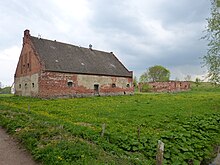Olszanowo
| Olszanowo | ||
|---|---|---|

|
|
|
| Basic data | ||
| State : | Poland | |
| Voivodeship : | Pomerania | |
| Powiat : | Człuchów | |
| Gmina : | Rzeczenica | |
| Geographic location : | 53 ° 41 ' N , 17 ° 8' E | |
| Residents : | 175 (March 31, 2011) | |
| Postal code : | 77-304 | |
| Telephone code : | (+48) 59 | |
| License plate : | GCZ | |
| Economy and Transport | ||
| Street : | Ext. 202 : → Czarne | |
| Rail route : | no rail connection | |
| Next international airport : | Danzig | |
Olszanowo (German Elsenau , also Elßenow or Elzanowo , Kashubian Òlszónowò ) is a village in the Polish Pomeranian Voivodeship and part of the rural community Rzeczenica ( Stegers ) in the powiat Człuchowski ( Schlochau district ).
Geographical location
Olszanowo is located in Western Pomerania , about fifteen kilometers west of the district town of Człuchów ( Schlochau ) and ten kilometers south of the town of Rzeczenica ( Stegers ). The village lies west of an extensive lake landscape, consisting of Szczytno Wielkie , Jezioro Krępsko and Jezioro Olszanowskie (about two kilometers to the southeast).
history
Olszanowo was originally laid out as a street village with an estate. In the course of time, scattered settlements emerged next to the village. The name Elsenau was first mentioned in 1376 in a document to secure border rights. In the same year, Grand Master Winrich von Kniprode granted Herman von dem Walde , a scion of an old Osnabrück dynasty, some Hufen land in Elßenow . In the centuries that followed, large parts of the Elsenau area repeatedly lay desolate and remained unused. Until the middle of the 17th century, only 1/5 of the district was used for agriculture. The Lembke family were the landlords at that time . The owners of the estate and village of Elsenau changed several times. Only the Manteuffel-Kiełpiński family was listed as acquirers of Elsenau twice, in 1723 and 1772. At that time Elsenau consisted of 7.5 Hufen Vorwerks- and 10.5 Hufen Bauernland. In addition to the manor, 3 farmers and 27 families lived in the village. In 1826 the manor and village were separated in the course of regulation . Previously up to 12 farmers cultivated the land in the village, after the reform there were only 5 and 3 smaller landowners. The manor was sold several times in the following period.
In 1872 the place Gertzberg was incorporated into the community. Around 1895, a large number of people from the Ukraine ( Volhynia ) and Westphalia settled in Elsenau, so that the population rose by leaps and bounds. In 1928 the estate and village were reunited. After the Second World War, the place was renamed Olszanowo by the Poles and until 1973 assigned to the rural community of Barkowo ( Barkenfelde ).
school
A school had existed in Elsenau since the beginning of the 19th century. In 1889 a half-day school had to be set up because of the large number of students. From 1920 two teachers taught at the school. The building was built in 1914 and expanded around 1940, so that the school was once considered one of the most modern in the district.
church
The church in Elsenau has been a Protestant church since the time it was built. In the first half of the 20th century, 86.5% of the population were of Protestant denomination. In the previous century, more than 95% of the population was Protestant. Around 1800 the Elsenau parish was one of the largest in the district with 120 localities. Before the Second World War , the parish comprised six parishes, including Bärenwalde and Bischofswalde as subsidiary churches , Geglenfelde , Loosen and Ruthenberg . Since 1947 the church has been Catholic and dedicated to Saint Francis of Assisi.
Attractions
Due to its charming location, the place has long been considered one of the most beautiful excursion destinations in the district. With an altitude between 125 and 211 m above sea level, it was also one of the highest places.
- Church of St. Franziskus von Assisi from the 17th century, built in the Prussian style (half-timbered building) as a Protestant church in a frame construction with a tower on the central aisle. Renovated in 1688 on behalf of the Hautmann von Weiher . The wooden tower was later built by order of Franciszek Ewald von Manteuffel-Kiełpiński in the 18th century.
- Rococo altar and the pulpit of the church from the 17th century with a baroque bell from 1771 (donated by Franciszek Ewald von Manteuffel-Kiełpiński ).
- Erratic block on the former estate (largest glacial debris of the former West Prussian-Posen border region).
Personalities who have worked locally
- Franciszek Ewald Manteuffel-Kiełpiński (1705 ~ 1779), Polish a. Saxon Royal Chamberlain, Starost von Gąbin and Asessor von Człuchów .
literature
- Manfred Vollack, Heinrich Lemke: The Schlochau district - a book from Prussian-Pomeranian homeland . Kiel 1974, ISBN 3-9800051-1-9 .
- Jerzy Ryszard Lissowski: Pomorskie uroczyska: między Słupią, Łebą i Brdą . Słupsk 2002.
- Max Bär : The nobility and aristocratic property in Polish Prussia at the time of the Prussian occupation . Pagelkau 1933.
Web links
- Stegers and surrounding communities in the home district of Schlochau
- Olszanowo on the Gmina Rzeczenica website
- Historical town views
- Image gallery Church
Individual evidence
- ^ CIS 2011: Ludność w miejscowościach statystycznych według ekonomicznych grup wieku (Polish), March 31, 2011, accessed on June 27, 2017
- ↑ Polska niezwykla: Szachulcowy kościół for Pocz. XVII w. on-line









